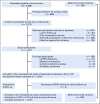Leydig Cell Function in Male Survivors of Childhood Cancer: A Report From the St Jude Lifetime Cohort Study
- PMID: 31557085
- PMCID: PMC6839908
- DOI: 10.1200/JCO.19.00738
Leydig Cell Function in Male Survivors of Childhood Cancer: A Report From the St Jude Lifetime Cohort Study
Abstract
Purpose: Direct assessment of Leydig cell function in childhood cancer survivors has been limited. The objectives of this study were to describe the prevalence of and risk factors for Leydig cell failure (LCF), Leydig cell dysfunction (LCD), and associated adverse health outcomes.
Patients and methods: In this retrospective study with cross-sectional health outcomes analysis, we evaluated 1,516 participants (median age, 30.8 years) at a median of 22.0 years after cancer diagnosis. LCF was defined as serum total testosterone less than 250 ng/dL (or 8.67 nmol/L) and luteinizing hormone greater than 9.85 IU/L, and LCD by testosterone as 250 ng/dL or greater and luteinizing hormone greater than 9.85 IU/L. Polytomous logistic regression evaluated associations with demographic and treatment-related risk factors. Log-binomial regression evaluated associations with adverse physical and psychosocial outcomes. Piecewise exponential models assessed the association with all-cause mortality.
Results: The prevalence of LCF and LCD was 6.9% and 14.7%, respectively. Independent risk factors for LCF included an age of 26 years or older at assessment, testicular radiotherapy at any dose, and alkylating agents at cyclophosphamide equivalent doses of 4,000 mg/m2 or greater. The risk increased with older age, higher doses of testicular radiotherapy, and cyclophosphamide equivalent doses. LCF was significantly associated with abdominal obesity, diabetes mellitus, erectile dysfunction, muscle weakness, and all-cause mortality. LCD was associated with unilateral orchiectomy and the same risk factors as LCF; no significant associations were found with adverse physical or psychosocial outcomes.
Conclusion: Older age, testicular radiotherapy, and exposure to alkylating agents were associated with LCF, which was associated with adverse physical and psychosexual outcomes. LCD, although having similar risk factors, was not associated with adverse health outcomes. Additional studies are needed to investigate the role of sex hormone replacement in mitigating the burden from adverse outcomes in survivors.
Figures
References
-
- Oeffinger KC, Mertens AC, Sklar CA, et al. Chronic health conditions in adult survivors of childhood cancer. N Engl J Med. 2006;355:1572–1582. - PubMed
Publication types
MeSH terms
Substances
Grants and funding
LinkOut - more resources
Full Text Sources
Medical
Research Materials


